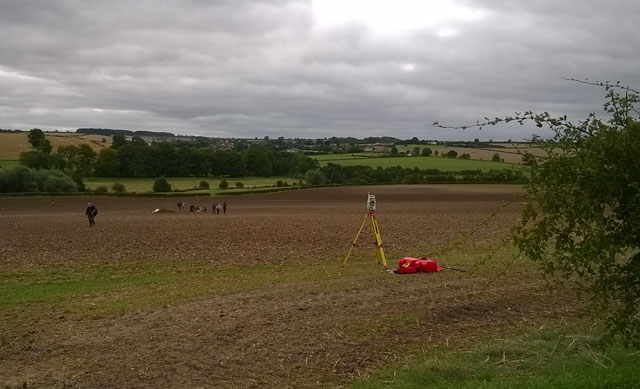A major step forward for us as we opened our first trench this year at the Binbrook site today. Our aim was to examine a large circular ‘anomaly’ found during the geophysical survey in the previous season. This was the work of Lloyd Bosworth (University of Kent) who identified the location again this year using GPS. The survey of last year gave us precise locations of the Roman remains and this is being used in this year’s excavation campaign. This survey – using magnetometry, showed the site outline that lies hidden under the top soil.
We also finished our fieldwalking survey. Points in this large field were triangulated and pottery and tile samples were collected by the students and local society members. These will be studied and fully recorded subsequently. After a morning of fieldwalking by students and volunteers, we begun to more closely examine the circular ‘anomaly’ prominently exposed via the geophysics last year.
We engaged in our first excavation with enthusiasm and patience, though we were not to fully understand the strenuous nature which the activity entailed till we had been at it for a few hours! Initial removal of top soil was followed by scanning the soil as it was removed, before moving it outside the direct parameters of our trenches. Following this, the ploughsoil was on the spoil heap, following diligent examination for any artefact remains. Armed solely with trowels, knee cushions and elbow grease we set about trowelling clean the area of our trench to see if we could see this ’anomaly’. Trowels are the most often used equipment in archaeology. Soil is slowly moved by the side of the trowel and collected into hand shovels. The trowel enables the site to be uncovered systematically and helps the excavators to identify materials and changes in soil, precisely and carefully. We were able to handle this responsibility well and used a firm hand to uncover the top of the ancient soils below the farmland ploughsoil.
The immediate result of the trowel work enabled the natural chalk level to be visible as it could be seen in some areas of the trench. The ‘anomaly’ was there, which confirmed the accuracy of the geophysical survey. We shall be interested to see what it contains; it seems like a big pit 5m across. Lloyd said the readings suggest the signal is not caused by iron: but he tells us something has been heated up. Steve Willis said it could be a well.
By the end of the day our trench measured 15m in length and 1m in width. The finds of copper slags of metal working, well-preserved oyster shells and specks of charcoal were found within the top of the ancient soils we were trowelling to reveal. A mixed variety of expectations are brought to the table by the students. Some of us expect to learn excavation skill but find very few artefacts or bits of evidence, and some students expect to find a substantial amount of Roman remains in the trenches and via the surveys.
We hope to ascertain whether the anomaly holds something special; at present it looks like a double halo feature within the Trench. We also aim to see if elsewhere we can locate building foundations relating to the Roman site. Further digging will be required. The work on site has been important to identify the skills and equipment needed for archaeology by the undergraduates and local volunteers and we hope to learn more. For more updates watch this space and we hope you join us in our first journey in archaeological practice. Lloyd is continuing the survey this year and we await the provisional results when they are downloaded to the computer. A great find has been a Roman coin of ‘The House of Constantine’ – depicting Crispus (AD 322) minted in Trier (see picture).
The other picture today shows the field looking to the stream.


